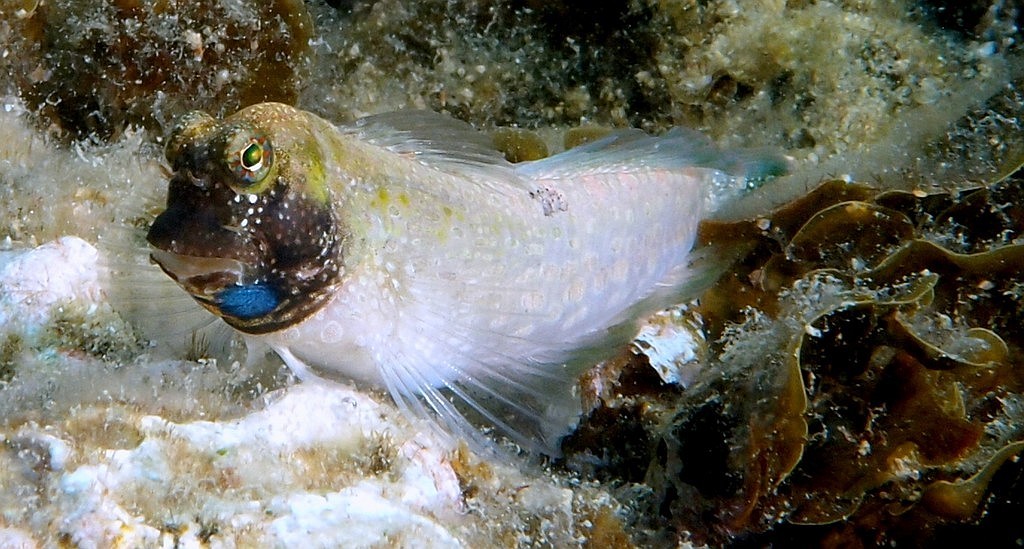SALARIAS ALBOGUTTATUS - (KNER, 1867)
Actinopterygii (Gigaclass) > Actinopteri (Class) > Teleostei (Subclass) > Blenniiformes (Order) > Blennioidei (Suborder) > Blenniidae (Family) > Salariinae (Subfamily) > Salarias (Genus)
Blennie à points blancs, White-spotted blenny, Whitespotted Blenny, 白点凤鳚,
Synonyme
Salarias irroratus (Alleyne & Macleay, 1877)
-------------------------
Description
Dorsal spines (total): 12; Dorsal soft rays (total): 16-18; Anal spines: 2; Anal soft rays: 18-19. Pectoral fin rays: 13-14. The head equals the depth, 4.37 times in the length. The breadth of the head equals its own depth. The forehead is very short, protuberant, and rounded. The very prominent eyes are 3.2 times in the head. Max. length: 9.0 cm TL, usually: 6.5 cm TL. Depth range: 1 - 8 m.
Color
A small greyish to brownish blenny with small white spots on the head, and irregular rows of oval spots or dashes and 7-8 indistinct brownish bars on sides. Breeding males have a dark head with a bright blue spot on either side of the throat.
Etymology
Salarias: from Latin, salarius = salt. Etymology unknown.
alboguttatus: from ancient Greek, alphós = whiteness, white (properly without luster), dull white + from Latin, guttātus = spotted, speckled. Referring to white spots on sides.
Original description: Salarias alboguttatus Kner, 1867 - Type locality: Samoa Islands.
Distribution
Western Pacific: Philippines, Palau, Papua New Guinea, eastern Australia, Solomon Islands, New Caledonia, Fiji and Samoa.
Blennie à points blancs, White-spotted blenny, Whitespotted Blenny, 白点凤鳚,
Synonyme
Salarias irroratus (Alleyne & Macleay, 1877)
-------------------------
Description
Dorsal spines (total): 12; Dorsal soft rays (total): 16-18; Anal spines: 2; Anal soft rays: 18-19. Pectoral fin rays: 13-14. The head equals the depth, 4.37 times in the length. The breadth of the head equals its own depth. The forehead is very short, protuberant, and rounded. The very prominent eyes are 3.2 times in the head. Max. length: 9.0 cm TL, usually: 6.5 cm TL. Depth range: 1 - 8 m.
Color
A small greyish to brownish blenny with small white spots on the head, and irregular rows of oval spots or dashes and 7-8 indistinct brownish bars on sides. Breeding males have a dark head with a bright blue spot on either side of the throat.
Etymology
Salarias: from Latin, salarius = salt. Etymology unknown.
alboguttatus: from ancient Greek, alphós = whiteness, white (properly without luster), dull white + from Latin, guttātus = spotted, speckled. Referring to white spots on sides.
Original description: Salarias alboguttatus Kner, 1867 - Type locality: Samoa Islands.
Distribution
Western Pacific: Philippines, Palau, Papua New Guinea, eastern Australia, Solomon Islands, New Caledonia, Fiji and Samoa.
Biology
Adults are found in shallow lagoon reefs, on algal covered rocks and rubble, often seen on the top of large Porites coral heads. Detritivore, uses its teeth to comb small particles of organic material from turf algae. Oviparous. Eggs are demersal and adhesive, and are attached to the substrate via a filamentous, adhesive pad or pedestal. Larvae are planktonic, often found in shallow, coastal waters. Facultative air-breathing.
Similar species
Adults are found in shallow lagoon reefs, on algal covered rocks and rubble, often seen on the top of large Porites coral heads. Detritivore, uses its teeth to comb small particles of organic material from turf algae. Oviparous. Eggs are demersal and adhesive, and are attached to the substrate via a filamentous, adhesive pad or pedestal. Larvae are planktonic, often found in shallow, coastal waters. Facultative air-breathing.
Similar species
Glyptoparus delicatulus (Smith, 1959) - Reported from Indo-West Pacific: East Africa (Mozambique, Kenya), Seychelles, Madagascar and western Mascarenes (La Réunion, Mauritius) east to Pohnpei (Micronesia) and Austral Islands (French Polynesia), north to Ryukyu Islands (Japan) and Ogasawara Islands (Japan), south to Western Australia. Has a distinctive black bar across the chin and a dark spot on each side of the gill membrane just in front of the pectoral base.
Nannosalarias nativitatis (Regan, 1909) - Reported from New Caledonia. A simple tentacle above eye, small white spots on face and large black spot on throat. Males have a distinct black blotch ventrally on each side of the head.
Salarias luctuosus (Whitley, 1929) - Reported from Western North Pacific. Both sexes with low occipital crest. Breast and anterior part of dorsal fin with characteristic markings.
Last update: 16, March 2023
Salarias luctuosus (Whitley, 1929) - Reported from Western North Pacific. Both sexes with low occipital crest. Breast and anterior part of dorsal fin with characteristic markings.
Last update: 16, March 2023
